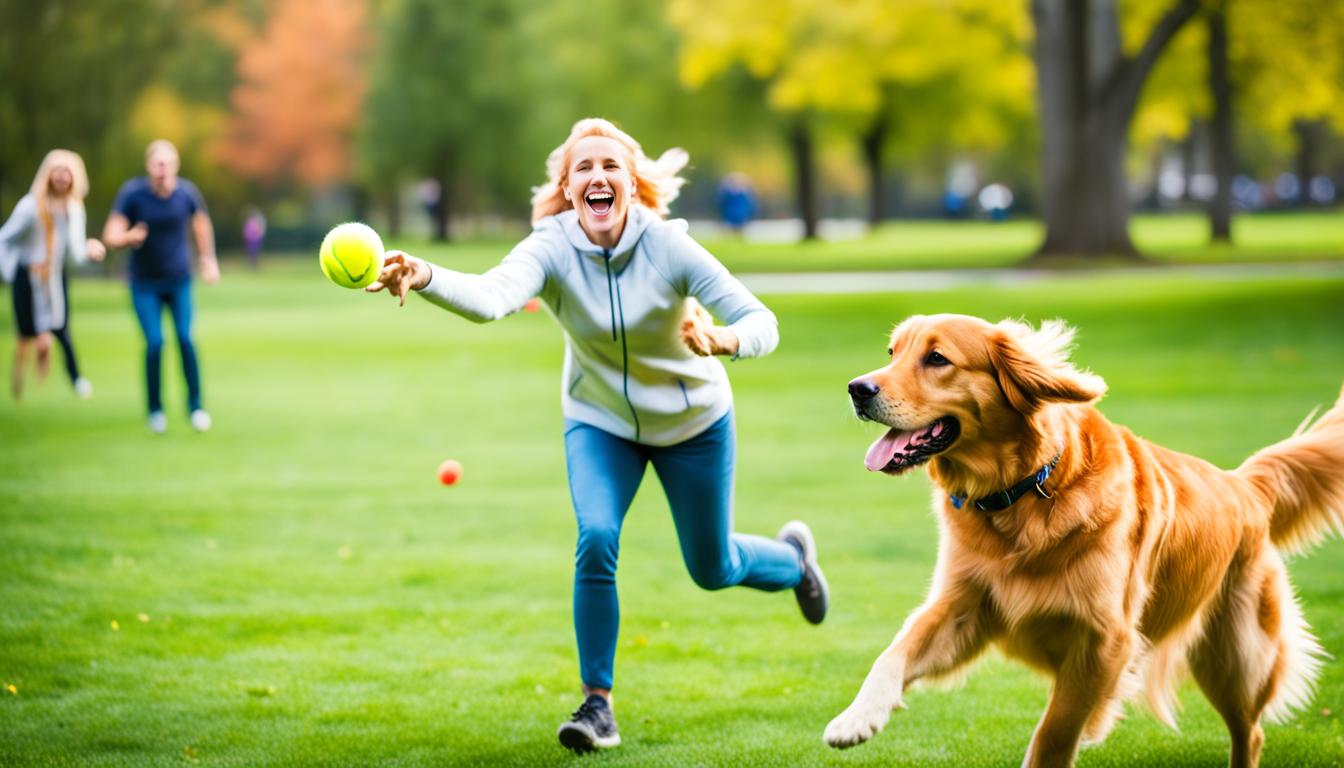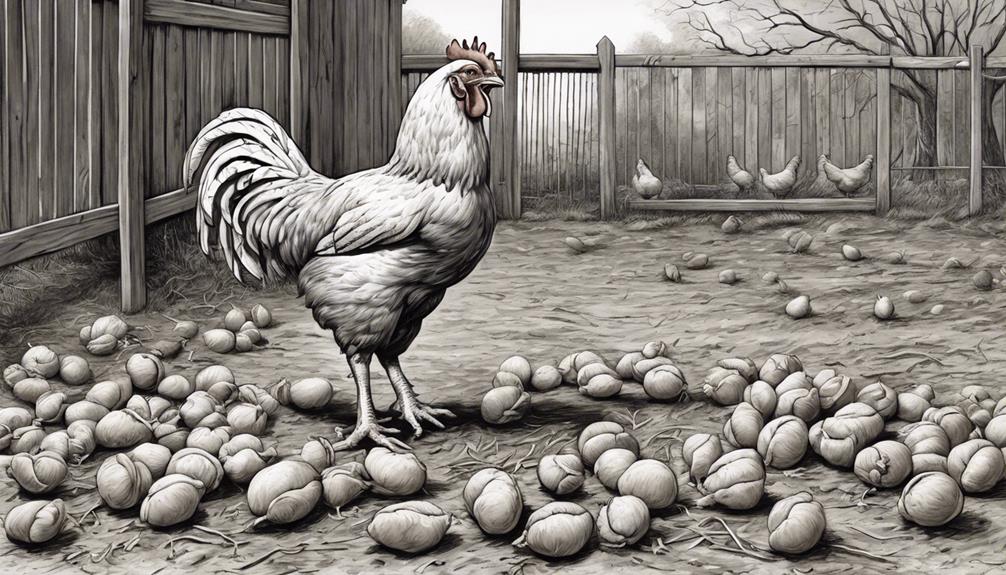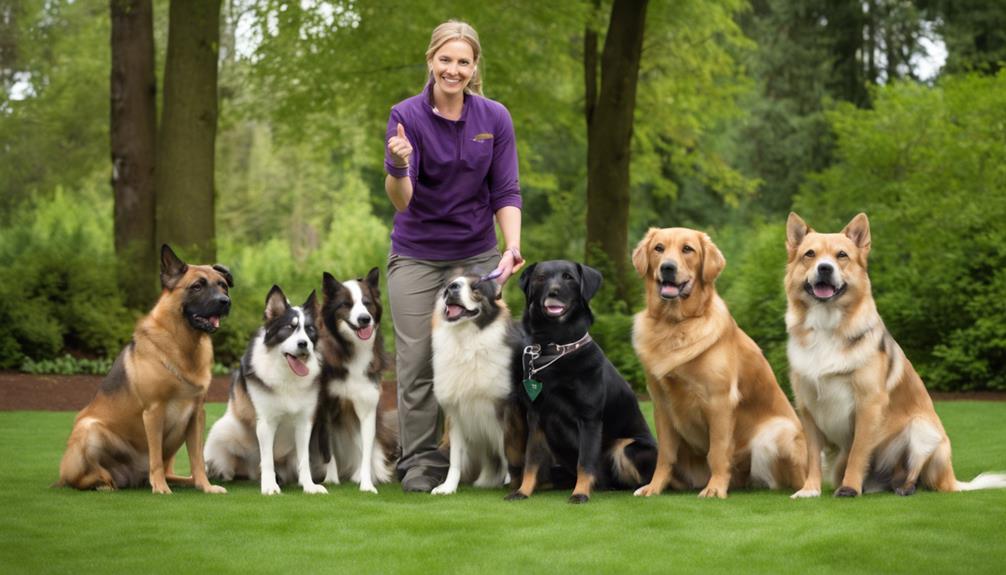Did you realize that there are about 89.7 million pet dogs in the United States alone? That is an astounding number of wagging tails and wet noses that rely on us for their care and well-being. As conscientious dog owners, it is our responsibility to offer top-notch care for our furry companions. From fulfilling their fundamental necessities to preserving their overall health, there are numerous crucial aspects to take into account. Therefore, if you are prepared to be the finest dog parent you can possibly be, let’s explore some professional advice and health tips to guarantee that your dog enjoys a joyful and healthy existence.
Key Takeaways:
- Meeting your dog’s basic needs, such as providing nutritious food, clean water, and toys for mental stimulation, is crucial for their well-being.
- Monitoring your dog’s food consumption and avoiding overfeeding helps maintain a healthy weight and prevents obesity-related health issues.
- Regular grooming, including bathing, brushing their coat, and trimming their nails, keeps your dog clean and comfortable.
- Proactive veterinary care, including routine check-ups and vaccinations, is essential for maintaining your dog’s health.
- Training, bonding, and providing mental and physical stimulation are important for your dog’s overall happiness and behavior.
Meeting Your Dog’s Basic Needs
As responsible pet owners, it’s our duty to ensure that our furry companions have their basic needs met. By providing nutritious food, clean water, tasty treats, stimulating toys, and cozy bedding, we can keep our dogs healthy, happy, and thriving.
Nutritious Food for Dogs
Feeding our dogs a high-quality and balanced diet is crucial for their overall well-being. Look for dog food brands that contain real meat, whole grains, and essential vitamins and minerals. Consult with your veterinarian to determine the right portion sizes and feeding schedule based on your dog’s age, size, and activity level.
Water and Treats for Dogs
Hydration is key to a dog’s health. Always provide your furry friend with fresh, clean water. Make sure to change the water frequently to prevent any bacterial growth. Additionally, treats can be a great way to reward your dog for good behavior or as an occasional snack. Opt for treats that are specially formulated for dogs and avoid giving them human food, which may be harmful to their health.
Dog Toys and Bedding
To keep your dog mentally stimulated and physically active, offer a variety of toys that cater to their natural instincts. From interactive puzzle toys to sturdy chew toys, find options that match your dog’s size and preferences. Alongside toys, providing your dog with a comfortable bed or crate helps create a safe and cozy space for them to rest and relax.
| Benefits of Meeting Your Dog’s Basic Needs |
|---|
| Improved overall health |
| Enhanced mental stimulation |
| Physical activity and exercise |
| Lower risk of behavioral problems |
| Stronger bond with your dog |
By providing nutritious food, clean water, engaging toys, and comfortable bedding, we can ensure that our dogs’ basic needs are met. This not only contributes to their overall health and happiness but also strengthens the bond between us and our furry friends.
Monitoring Food Consumption
Overweight dogs are prone to various health issues, including metabolic abnormalities and cardiovascular diseases. To prevent these risks and maintain a healthy weight for your furry companion, it is essential to monitor their food consumption and practice portion control.
Food portion control for dogs is crucial in preventing obesity and promoting optimal health. By carefully measuring their meals and avoiding overfeeding, you can ensure that your dog receives the right amount of nutrition without excessive calorie intake.
“Portion control helps prevent dog obesity and promotes a healthy weight.”
Here are some tips to help you implement food portion control for your dog:
- Consult with your veterinarian to determine the appropriate portion size for your dog’s breed, age, and activity level.
- Use a measuring cup or scale to accurately measure your dog’s food portions instead of relying on estimates.
- Divide your dog’s daily food allowance into multiple small meals throughout the day to prevent overeating.
- Avoid free-feeding or leaving food out all day, as this can lead to excessive snacking and weight gain.
- Consider using interactive feeding toys or puzzles to slow down your dog’s eating pace and provide mental stimulation.
By monitoring your dog’s food consumption and practicing portion control, you can help them maintain a healthy weight, reduce the risk of obesity-related health problems, and promote their overall well-being.
| Benefits of Food Portion Control | Risks of Overfeeding |
|---|---|
|
|
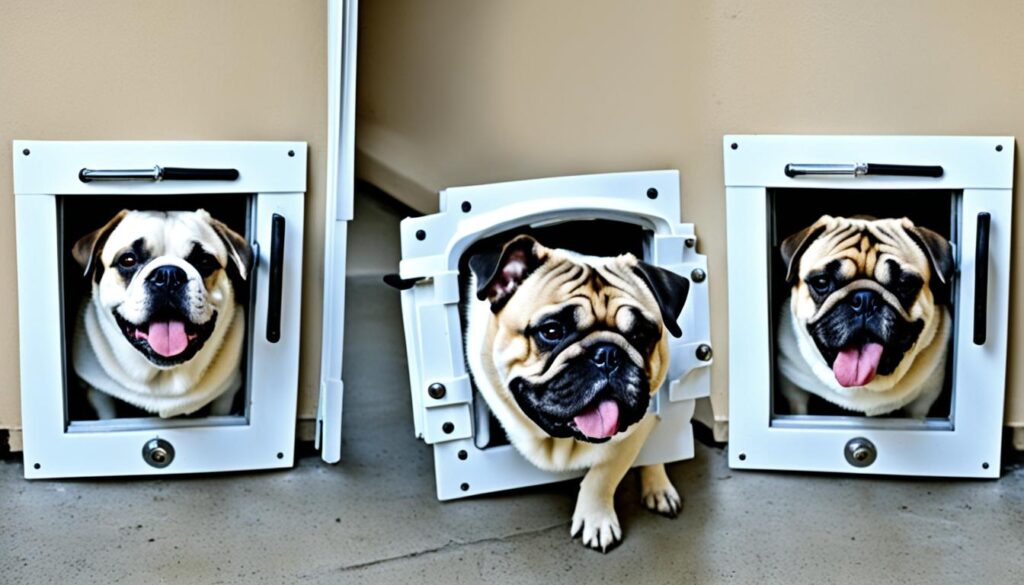
The Importance of Avoiding Overfeeding
Overfeeding your dog can have detrimental effects on their health and well-being. Excessive calorie intake leads to weight gain, which puts strain on their joints, heart, and other organs. It increases the risk of developing conditions such as:
- Diabetes
- Pancreatitis
- Arthritis
- High blood pressure
Preventing overfeeding through portion control is one of the most effective ways to combat dog obesity and promote a long and healthy life for your canine companion.
Providing Sufficient Water
When it comes to keeping our canine companions hydrated, providing access to clean and fresh water is crucial. Just like humans, dogs need a constant supply of water to maintain optimal health and prevent dehydration. So, let’s dive into some essential tips for ensuring your furry friend stays well-hydrated!
Keeping the Water Dish Fresh
Remember, dogs rely on us to keep their water dish clean and refreshing. Make sure to replenish their water regularly, especially during hot weather or after physical activity. Additionally, don’t forget to wash their water dish daily to prevent the buildup of harmful bacteria.
Choosing the Right Water Dish
While it may seem insignificant, the type of water dish you choose can impact your dog’s drinking experience. Opt for a sturdy and stable dish that won’t easily tip over. Additionally, consider the material of the dish. Stainless steel is an excellent choice as it is more hygienic, easy to clean, and doesn’t retain odors like plastic dishes do.
“Clean and fresh water is essential for a dog’s overall well-being. Ensuring your furry friend has access to clean water at all times helps prevent dehydration and promotes good health.”
The Importance of Clean Water
Just as we prefer drinking clean and pure water, our dogs deserve the same. Regularly changing the water in their dish prevents the accumulation of dirt, debris, and saliva that can contaminate the water. Clean water not only keeps your dog refreshed but also reduces the risk of gastrointestinal issues caused by consuming impurities.
Monitoring Your Dog’s Hydration
It’s essential to be aware of your dog’s hydration levels, especially during hot weather or strenuous activities. Some signs of dehydration in dogs include excessive panting, dry gums, loss of skin elasticity, and reduced energy. If you notice any of these symptoms, offer your dog water immediately and consult a veterinarian if the signs persist.
The Benefits of Clean Water for Dogs
| Benefits | Description |
|---|---|
| Proper hydration | Prevents dehydration and helps maintain overall health |
| Improved digestion | Reduces the risk of gastrointestinal issues caused by consuming impurities |
| Optimal organ function | Aids in the proper functioning of vital organs and metabolic processes |
| Regulated body temperature | Helps dogs regulate their body temperature, especially in hot weather |
| Healthy skin and coat | Contributes to a shiny coat and moisturized skin |
Providing clean and fresh water is a simple but significant way to prioritize your dog’s well-being. By implementing these tips, you can ensure that your furry friend stays hydrated and healthy!
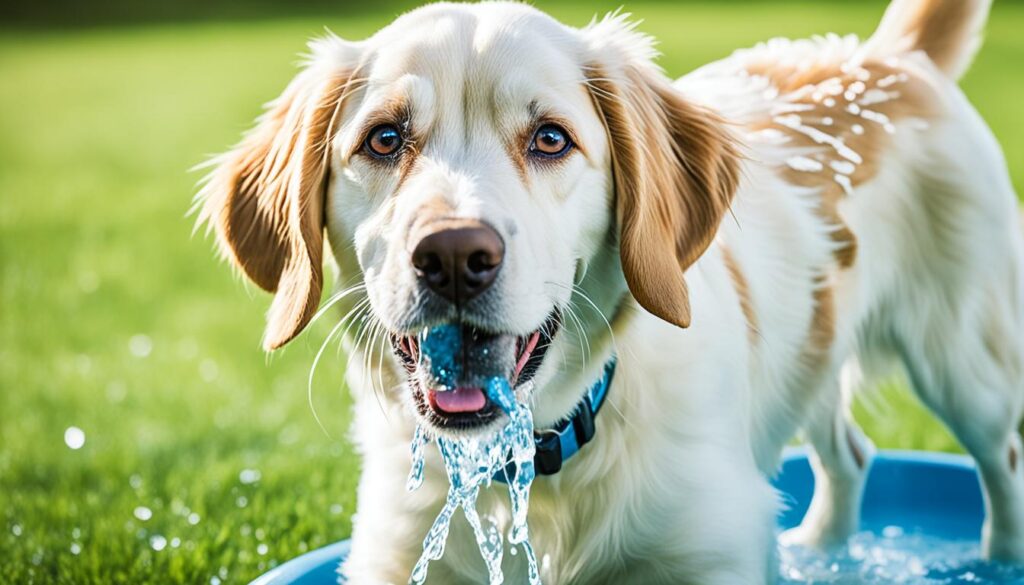
Regularly Grooming Your Dog
Regular grooming is an essential part of caring for your dog. Not only does it keep them clean and fresh, but it also helps prevent pests and potential health problems. Grooming includes bathing, brushing their coat, and trimming their nails, ensuring their comfort and overall well-being.
When it comes to bathing your dog, use a dog-specific shampoo and warm water. Make sure to thoroughly wet their coat and gently massage the shampoo into their fur, focusing on areas that may be dirty or have an odor. Rinse your dog thoroughly to remove all the shampoo, and then towel dry them or use a blow dryer on a low heat setting. Remember to avoid getting water in their ears and eyes.
Brushing your dog’s coat is important for several reasons. It helps remove loose hair, prevents matting, distributes natural oils, and stimulates blood flow to their skin. Use a brush suitable for your dog’s coat type, whether it’s short, long, curly, or double-coated. Brush in the direction of hair growth, being gentle and patient to avoid causing discomfort.
Trimming your dog’s nails is crucial to their comfort and health. Overgrown nails can be painful and may lead to difficulty walking and potential injuries. Use a dog nail trimmer or grinder and trim the nails gradually, being careful not to cut into the quick (the blood vessel inside the nail). If you’re unsure how to trim your dog’s nails properly, consult a professional groomer or your veterinarian.
Regular grooming sessions provide opportunities to check your dog’s overall health. Look for any abnormalities such as lumps, bumps, or skin irritations, and monitor their ears for signs of infection or excessive wax buildup. Taking care of your dog’s grooming needs not only keeps them looking their best but also allows you to maintain their health and well-being.
| Grooming Task | Frequency |
|---|---|
| Bathing | Every 4-6 weeks |
| Brushing | Daily or 2-3 times a week, depending on coat type |
| Nail Trimming | Monthly or as needed |
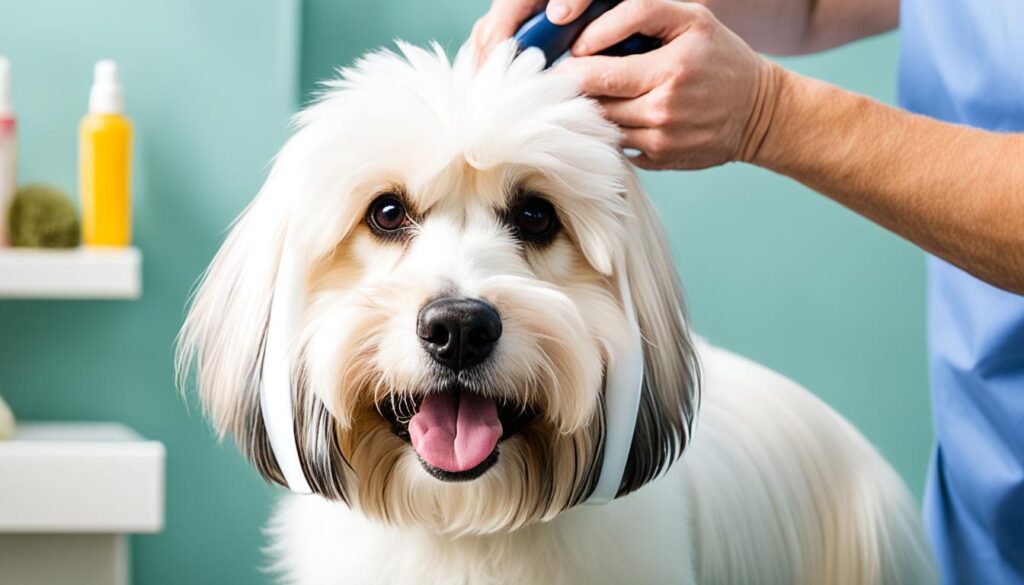
“Regular grooming not only keeps your dog clean and pest-free, but it also allows you to monitor their overall health and well-being.”
Maintaining Your Dog’s Health with Routine Care
As responsible pet owners, we understand the importance of proactive veterinary care in keeping our beloved dogs healthy and happy. Routine visits to the vet, along with discussions about preventative measures and vaccinations, play a crucial role in maintaining their overall well-being.
Annual Check-ups
Scheduling annual check-ups with your vet is essential for your dog’s health. During these visits, the vet will conduct a thorough examination to assess your dog’s physical condition and detect any potential health issues early on. Regular check-ups allow for early intervention, which can lead to better treatment outcomes and prevent more serious health problems.
Preventative Measures
Engaging in conversations about preventative measures with your vet is vital for protecting your dog from common health risks. Fleas, ticks, and heartworm are prevalent concerns that can lead to serious health issues if left untreated. By discussing preventative measures with your vet, you can ensure your dog receives appropriate treatments and medications to keep them safe and healthy.
Vaccinations
Vaccinations are an essential aspect of your dog’s routine care. They provide protection against various diseases and help prevent the spread of illnesses within the dog population. Regularly vaccinating your dog ensures their immune system is prepared to fight off potential threats and reduces the risk of illness. Consult with your vet to determine the appropriate vaccination schedule for your dog.

| Benefits of Routine Vet Visits | Pet Insurance for Dogs |
|---|---|
|
|
“Routine veterinary care is crucial for maintaining your dog’s health and preventing potential health problems. By scheduling regular check-ups, discussing preventative measures, and ensuring vaccinations are up to date, you can provide your furry friend with the best possible care.”
Considering Spaying or Neutering
When it comes to responsible pet ownership, spaying or neutering your dog is an important decision. Not only does this procedure help control the pet population, but it also offers several health benefits for your furry friend.
Spaying refers to the surgical removal of a female dog’s ovaries and uterus, while neutering involves the removal of a male dog’s testicles. These procedures are typically performed by a veterinarian under general anesthesia. Let’s explore the health advantages of spaying and neutering:
- Reduced risk of certain diseases: Spaying female dogs greatly reduces the risk of uterine infections, such as pyometra, which can be life-threatening. It also minimizes the possibility of mammary gland tumors, including malignant forms, when done before the first heat cycle.
- Prevention of reproductive conditions: Spaying eliminates the risk of ovarian and uterine-related conditions, such as ovarian cysts, uterine prolapse, and uterine tumors. Neutering male dogs prevents testicular cancer and reduces the risk of prostate problems.
- Behavioral benefits: Spaying or neutering can help prevent unwanted behaviors related to sexual maturity, including territorial marking, aggression, roaming, and mounting.
- Population control: By choosing to spay or neuter your dog, you contribute to reducing the number of stray and unwanted animals, helping to alleviate the burden on shelters and rescues.
It’s important to consult with your veterinarian to determine the appropriate age for spaying or neutering your dog. While the procedure is generally safe, there can be slight risks associated with any surgery, such as infection or adverse reactions to anesthesia. However, the benefits of spaying or neutering your dog often outweigh the risks.
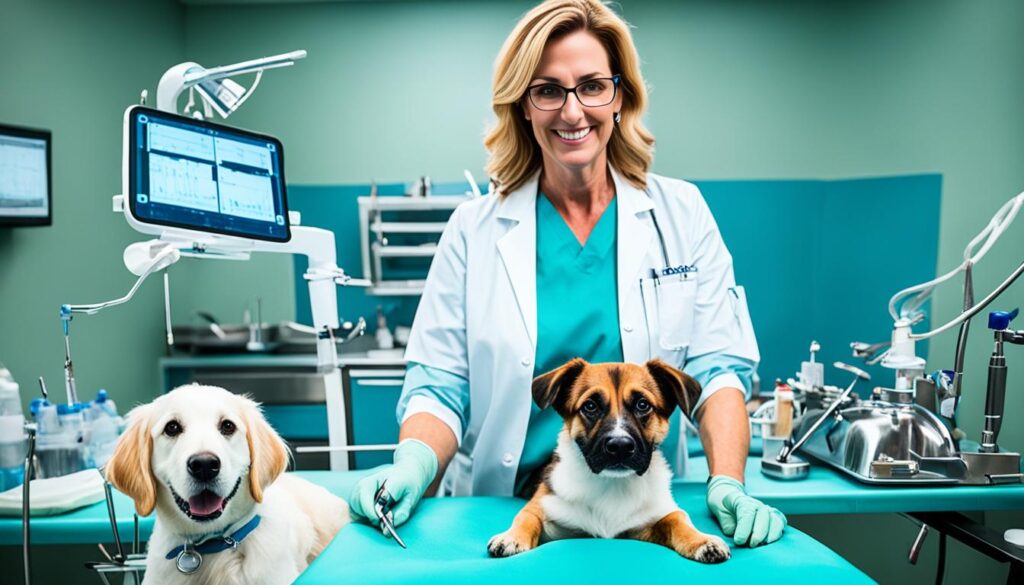
Spaying or neutering your dog brings both health benefits and contributes to the welfare of animals in general. By opting for these procedures, you are actively participating in responsible pet ownership and promoting the overall well-being of your four-legged companion. So, consider discussing spaying or neutering options with your vet today to ensure the long-term health of your beloved canine friend.
Brushing Your Dog’s Teeth
Dental care is often overlooked but crucial for maintaining your dog’s overall health. Similar to humans, dogs can develop dental problems such as gum disease, tooth decay, and bad breath. Regularly brushing your dog’s teeth is a simple and effective way to prevent these issues and avoid expensive dental cleanings.
To get started with dog dental care, you’ll need a dog toothbrush and toothpaste specifically formulated for canines. Never use human toothpaste, as it can be toxic to dogs. Instead, opt for a toothpaste with flavors that dogs find appealing, like poultry or beef.
Here are some steps to follow when brushing your dog’s teeth:
- Introduce your dog to the toothbrush gradually, allowing them to sniff and inspect it.
- Start by gently massaging their gums with your finger to get them comfortable with the sensation.
- Apply a small amount of dog toothpaste to the toothbrush and allow your dog to taste it.
- Gently lift your dog’s lip and begin brushing in circular motions on the outer surfaces of their teeth.
- Focus on the areas where plaque and tartar are most likely to accumulate, such as the back molars.
- Gradually increase the duration of each brushing session, aiming for at least 2-3 minutes.
- Offer praise and treats as positive reinforcement to make the experience more enjoyable for your dog.
Brushing your dog’s teeth at least 3 times a week is recommended for optimal dental care. However, if your dog is resistant to tooth brushing, there are alternative options available, such as dental wipes or water additives that can help maintain their oral hygiene.
“Regularly brushing your dog’s teeth can prevent dental illnesses and the need for expensive dental cleanings.”
In addition to regular brushing, it’s important to schedule annual dental check-ups with your veterinarian to monitor your dog’s dental health. They can provide professional cleanings if necessary and offer advice on how to improve your dog’s dental care routine.
Remember, a healthy mouth leads to a healthy dog. By implementing a proper dental care routine and being proactive about your dog’s oral health, you can ensure they have strong teeth and fresh breath for years to come.
Dog Dental Care Infographic
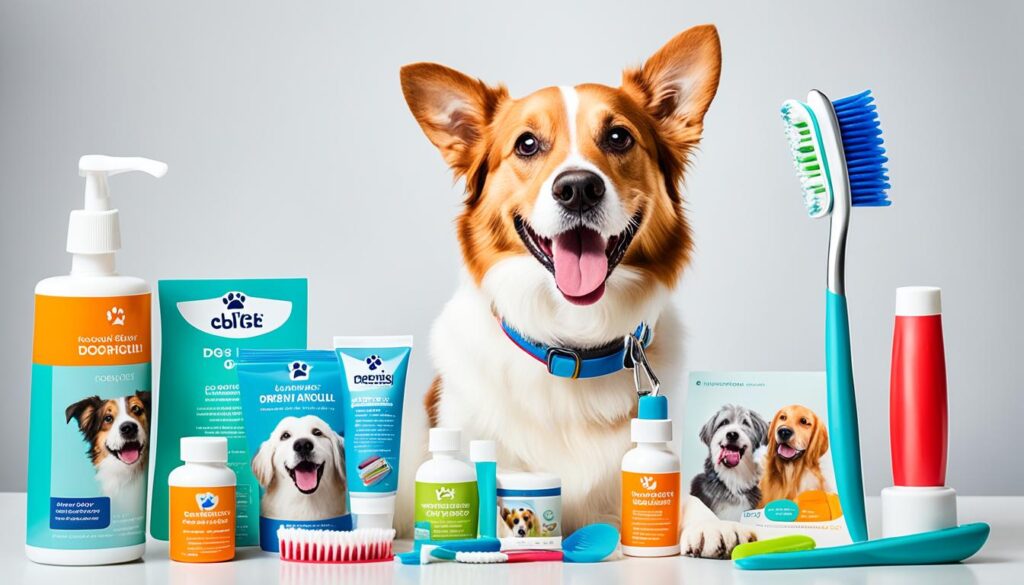
| Dental Care Tips | Benefits |
|---|---|
| Regular brushing | Prevents gum disease and tooth decay |
| Annual dental check-ups | Identifies and treats dental issues early |
| Dental treats and toys | Reduces plaque and tartar buildup |
| Proper diet | Supports healthy teeth and gums |
| Chew toys | Helps clean teeth and exercises jaw muscles |
Stimulating Your Dog’s Brain and Body
Dogs need a balance of physical exercise and mental stimulation to stay healthy and well-behaved. Providing opportunities for both can contribute to their overall well-being and happiness.
Regular Exercise
Exercise is essential for dogs to maintain a healthy weight, improve cardiovascular health, and strengthen their muscles. Daily walks, running sessions, or playtime in the park are great ways to keep your dog physically active. Remember to choose activities that suit their breed, age, and energy level. Some dogs may require more intense exercise, such as swimming or agility training, to keep them engaged and properly stimulated.
Teaching New Tricks
Teaching your dog new tricks not only challenges their brain but also improves their overall obedience and focus. Start with simple commands like sit, stay, and come, and gradually progress to more complex tricks like rolling over or playing dead. Use positive reinforcement techniques, such as rewards and praises, to motivate your dog during training sessions. This will create a positive and enjoyable learning experience for both of you.
Engaging Games
Interactive games that require problem-solving and decision-making can provide mental stimulation for dogs. Hide-and-seek, puzzle toys, and treat-dispensing games are great options to engage your dog’s brain and encourage them to think and strategize. These games also help prevent boredom and destructive behaviors that may arise from a lack of mental stimulation.
“Physical exercise and mental stimulation are equally important for dogs. By providing both, we can keep our furry friends happy, healthy, and well-behaved.”
Remember to tailor the exercise and mental stimulation activities to your dog’s individual needs and preferences. Always prioritize their safety and consult with a veterinarian if you have any concerns about physical limitations or mental health.
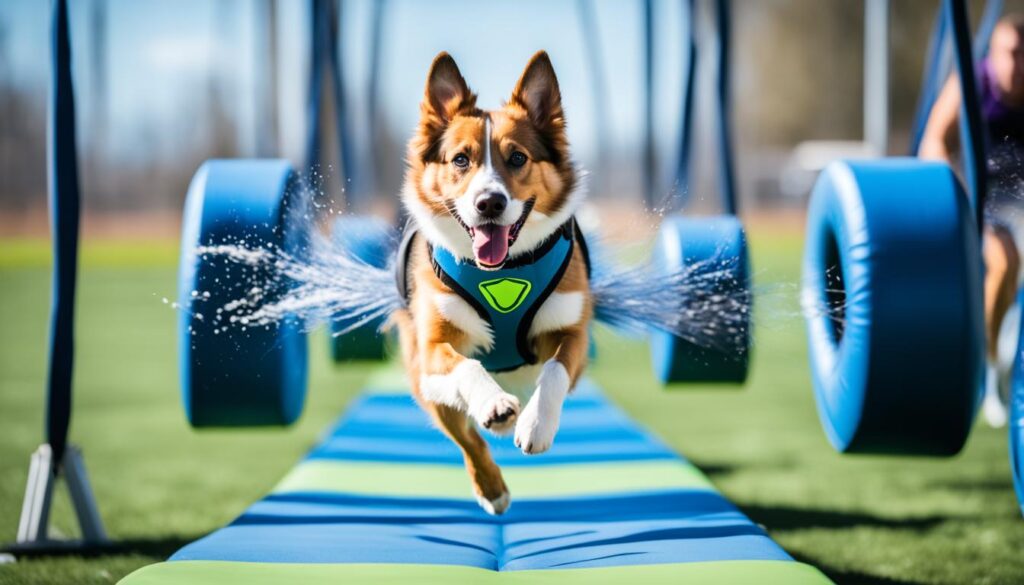
Summary:
Creating a balanced routine that includes regular exercise, teaching new tricks, and engaging in interactive games can stimulate your dog’s brain and keep them physically active. By providing mental and physical stimulation, we can ensure our dogs lead fulfilling and enriching lives.
Keeping Your Pet Safe
Ensuring the safety of your beloved dog is of utmost importance to us. By taking preventive measures, you can protect your furry friend from potential dangers. Here are some key steps to keep your pet safe:
1. Registering Your Pet
Registering your dog is an important step in safeguarding their well-being. It helps identify them and ensures a quick reunion in case they go missing. Registering your pet also helps authorities contact you in case of emergencies and facilitates a seamless identification process.
2. Microchipping Dogs
Microchipping your dog provides an added layer of security. It involves implanting a small, permanent chip under your dog’s skin, containing vital identification details. In the event that your pet gets lost or stolen, microchipping significantly increases the chances of a reunion by enabling shelters and veterinary clinics to scan for the chip and identify your contact information.
3. Securing Household Toxins
Creating a safe environment for your dog involves keeping potentially harmful substances out of their reach. Household toxins such as cleaning products, medications, and certain plants can pose serious health risks. Store these items securely and use pet-friendly alternatives whenever possible. It’s essential to be proactive in preventing accidental ingestion or exposure to harmful substances.
4. Creating a Safe Space
Providing your dog with a designated safe space ensures their physical and emotional well-being. This can be an enclosed area in your home, a crate, or a fenced yard. A safe space enables your dog to retreat to a calm and secure environment, especially during stressful situations such as thunderstorms or fireworks.
“By taking precautions and implementing safety measures, we can create a secure and protected environment for our canine companions.”
| Preventive Measures | Benefits |
|---|---|
| Registering your pet | Facilitates a quick reunion in case of loss or separation |
| Microchipping dogs | Increases the likelihood of finding lost or stolen pets |
| Securing household toxins | Prevents accidental ingestion or exposure to harmful substances |
| Creating a safe space | Provides a calming refuge during stressful situations |
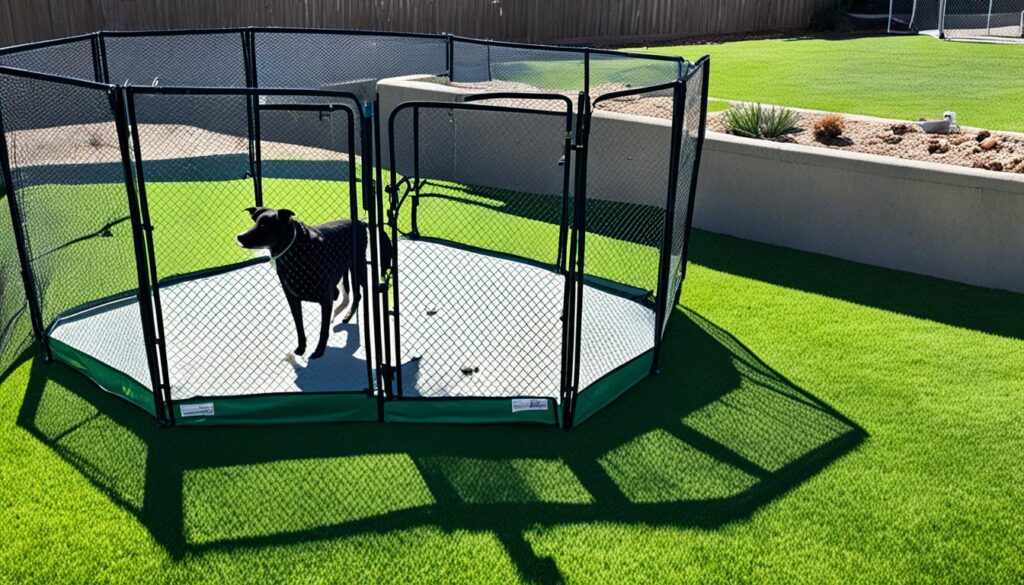
By taking precautions and implementing safety measures, we can create a secure and protected environment for our canine companions. Registering your pet, microchipping them, securing household toxins, and providing a safe space are essential steps in ensuring a happy and safe life for your dog.
Cleaning Your Dog’s Toys and Bedding
Regularly washing your dog’s toys, blankets, and bedding is essential for maintaining their hygiene and overall well-being. By removing germs, dirt, and allergens, you can help prevent potential irritations and health issues for your beloved pet. This practice becomes even more critical for dogs with seasonal allergies, as allergens can accumulate and trigger discomfort.
To ensure optimal dog toy hygiene, follow these simple steps:
- Gather all the toys and separate them based on their material type. Plush toys, rubber toys, and plastic toys may require different cleaning approaches.
- Check for any signs of wear and tear or small parts that could be hazardous if ingested. Replace any damaged or unsafe toys.
- If the toy is machine washable, place it in a mesh laundry bag and wash it on a delicate cycle with mild detergent. Air-drying is typically the best option, as excessive heat can damage certain materials.
- For rubber or plastic toys, soak them in warm water with a gentle pet-safe cleaner, and use a brush or toothbrush to remove any dirt or debris. Rinse thoroughly and allow them to air dry.
In addition to cleaning your dog’s toys, it’s important to regularly wash their bedding and blankets:
- Remove any loose fur or debris from the bedding by shaking them out or using a lint roller.
- Check the care instructions for the specific type of bedding. Most bedding can be machine washed on a gentle cycle with mild detergent.
- Use hot water to kill any mites, fleas, or other potential pests that may be present.
- Thoroughly dry the bedding to prevent the growth of mold or mildew.
By dedicating time to clean your dog’s toys and bedding regularly, you can help maintain a clean and healthy environment for your furry friend.
Avoiding Allergens in Your Dog’s Bedding
If your dog has seasonal allergies, it’s important to take extra precautions when cleaning their bedding. While regular washing removes dirt and allergens, using hypoallergenic detergents and avoiding fabric softeners can help minimize the risk of any residual irritants. Additionally, consider using allergen-resistant bedding materials or covers that can be easily removed and washed.
“Regularly washing your dog’s toys, blankets, and bedding is not only good for their health but also helps maintain a clean and comfortable environment for both you and your furry companion.”

| Type of Toy | Cleaning Method |
|---|---|
| Plush Toys | Machine wash on delicate cycle with mild detergent |
| Rubber Toys | Soak in warm water with pet-safe cleaner, rinse thoroughly, air dry |
| Plastic Toys | Soak in warm water with pet-safe cleaner, brush to remove dirt, rinse thoroughly, air dry |
Keeping Food Out of Your Dog’s Reach
As responsible dog owners, it is essential to be aware of human foods that can be toxic to dogs. While some foods may seem harmless to us, they can cause serious health consequences for our furry companions. To ensure the well-being of your dog, it is crucial to keep toxic foods like avocados, chocolate, and onions out of their reach.
Avocados contain a substance called persin, which can be toxic to dogs and cause stomach upset, breathing difficulties, and even heart damage. While you may enjoy this nutritious fruit, it’s important to remember that it can be harmful to your canine companion.
Chocolate, a favorite treat for many humans, contains theobromine, a compound that is toxic to dogs. Consuming chocolate can lead to symptoms such as vomiting, diarrhea, increased heart rate, and even seizures. It is vital to keep any chocolate products, including cocoa powder, chocolate bars, and baked goods, away from your dog.
Onions and garlic, commonly used in various dishes, contain compounds that can damage a dog’s red blood cells, leading to anemia. Even small amounts of onion or garlic can be harmful if ingested by your furry friend. Ensure that your dog does not have access to these ingredients or any dishes that contain them.

Remember, prevention is key when it comes to ensuring the safety of your dog’s diet. By keeping toxic foods out of their reach, you can protect them from potential health risks and ensure their well-being.
| Toxic Foods for Dogs | Potential Health Consequences |
|---|---|
| Avocado | Stomach upset, breathing difficulties, heart damage |
| Chocolate | Vomiting, diarrhea, increased heart rate, seizures |
| Onion and Garlic | Anemia, damage to red blood cells |
Using a Leash in Public
When it comes to walking your dog in public, leash safety is of utmost importance. Not only does it keep your furry friend under control, but it also helps prevent accidents and injuries. Using a leash ensures the safety of both your dog and others around you.
Leash training for dogs is a vital aspect of responsible pet ownership. It provides a means of communication between you and your dog, allowing you to guide them during walks and outings. A properly trained dog will understand that the leash is not a restraint but rather a tool for their safety and enjoyment.
There are several types of leashes available, including retractable leashes, adjustable leashes, and standard leashes. Choose the one that suits your dog’s size, temperament, and walking habits. Remember to keep the leash in good condition and regularly check for any signs of wear or damage.
When using a leash, it is recommended to keep it at a length that allows your dog to walk comfortably by your side without pulling or lunging. This promotes better leash manners and prevents potential accidents or entanglement with objects or other dogs.
“A well-trained dog walking on a leash is a testament to responsible pet ownership.”
Using a leash in public areas not only ensures your dog’s safety but also shows respect for the community and other pet owners. By keeping your dog on a leash, you minimize the risk of them running into busy streets, provoking other dogs, or causing harm to themselves or others.
Remember, accidents can happen in an instant, even with the most well-behaved dogs. By using a leash, you can quickly regain control and prevent potential dangers. Additionally, leash safety is crucial for dogs with reactive behaviors or fear-based issues, as it helps create a sense of security and prevents them from feeling overwhelmed in public settings.
“A leash is a lifeline that keeps our beloved companions safe and protected.”
So, the next time you venture out with your furry friend, always remember to use a leash. It not only ensures their safety but also promotes responsible dog ownership and fosters harmony within your community.

Benefits of using a leash when walking your dog:
- Prevents your dog from running into traffic or dangerous situations
- Helps control reactive or anxious behaviors
- Keeps your dog from approaching other dogs or people without consent
- Allows you to guide and redirect your dog’s movements
- Helps maintain better leash manners and walking etiquette
Training and Bonding with Your Dog
When it comes to training your dog, it’s not just about teaching them commands and tricks. Training is also an opportunity to deepen the bond between you and your furry friend. By dedicating one-on-one time, practicing patience, consistency, and utilizing positive reinforcement techniques, you can strengthen your relationship and create a harmonious partnership with your dog.
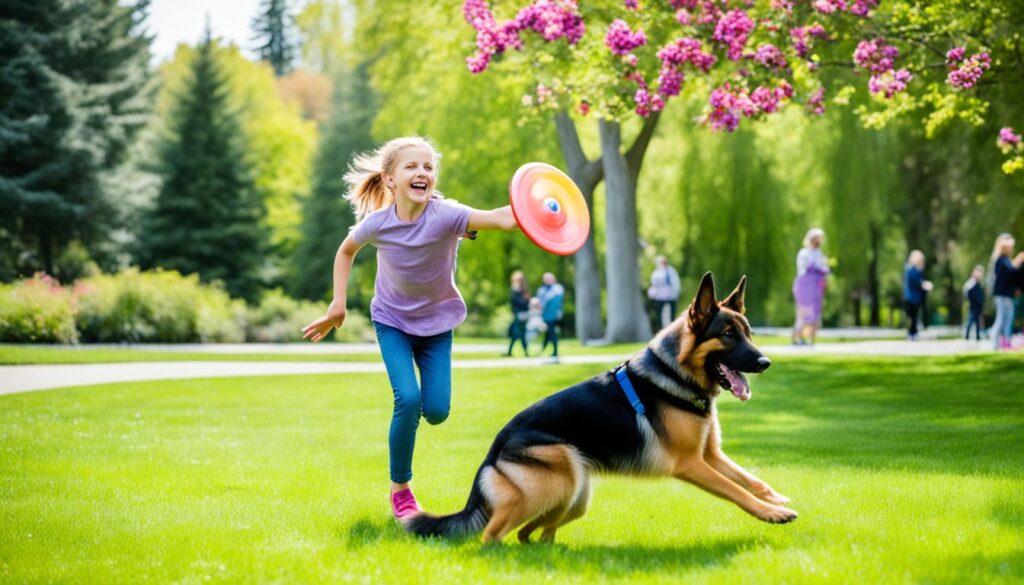
Positive reinforcement training is an effective and humane approach that rewards desired behaviors with treats, praise, or play. This method focuses on rewarding your dog for doing what you want them to do, rather than punishing them for their mistakes. It helps build trust, fosters cooperation, and strengthens the bond between you and your dog.
“Training is not about dominating your dog; it’s about building a partnership based on trust and respect.”
Consistency is key when it comes to training your dog. Establish clear and consistent cues for different commands and be sure to use them in a variety of situations. This will help your dog understand what is expected of them and reinforce their training. Patience is also crucial, as every dog learns at their own pace. Stay calm and positive, and celebrate even the smallest victories during the training process.
Training sessions should be short and frequent, ideally lasting no more than 10-15 minutes each. Regularly reinforcing learned behaviors through practice and repetition will help solidify your dog’s understanding and ability to follow commands.
Additionally, incorporating bonding activities into your training routine can further strengthen your connection with your dog. These activities can include interactive play sessions, leisurely walks, or even cuddle time. Remember, dogs are social animals and thrive on companionship and attention.
Bonding Activities:
- Engage in interactive play with toys that promote mental stimulation, such as puzzle toys or treat dispensers.
- Take leisurely walks together, allowing your dog to explore their surroundings and enjoy the outdoors.
- Integrate regular grooming sessions into your routine, providing an opportunity for physical closeness and bonding.
- Dedicate time each day for training exercises, focusing on positive reinforcement and rewarding good behavior.
Tips for Successful Training:
- Start training your dog from a young age, as puppies are more receptive to learning and adapting.
- Be consistent with your commands and use positive reinforcement techniques consistently.
- Create a calm and quiet training environment, free from distractions that may hinder your dog’s focus.
- Always end training sessions on a positive note, with praise and rewards for a job well done.
Remember, training and bonding with your dog is a lifelong journey. It requires patience, understanding, and a commitment to nurturing a strong and loving relationship. By prioritizing training sessions, practicing positive reinforcement techniques, and engaging in bonding activities, you’ll not only have a well-behaved dog but also a loyal and devoted companion.
Seasonal Care Tips
As responsible dog owners, we understand that different seasons require different care for our furry friends. It’s important to adapt our dog’s care routine to ensure their well-being in both winter and summer. By paying attention to their time outside, their paw health, and adjusting their overall care according to weather conditions, we can keep them safe and comfortable.
Winter Care for Dogs
In the winter, it’s crucial to protect our dogs from the cold and harsh weather. Here are some essential winter care tips:
- Limit outdoor time during extremely cold temperatures. Frostbite and hypothermia can occur if they’re exposed for too long.
- Keep them warm and cozy indoors with a comfortable bed and blankets.
- Protect their paws from ice, snow, and salt by using dog-friendly shoes or applying pet-safe paw balm.
- Make sure they have access to fresh water that isn’t frozen.
- Keep them well-groomed to prevent fur matting and ice buildup on their coat.

Summer Care for Dogs
In the summer, our dogs need extra attention to stay cool and prevent overheating. Follow these summer care tips:
- Avoid walking your dog on hot pavement, as it can burn their paws. Stick to grassy areas or use protective dog booties.
- Provide ample shade and ensure your dog has access to fresh water at all times.
- Never leave your dog in a parked car, even for a few minutes. The temperature inside a car can rise rapidly.
- Take walks during cooler parts of the day, such as early morning or late evening.
- Consider getting a cooling mat or bandana to help your dog stay comfortable.
Dog Safety in Extreme Weather
Extreme weather conditions can pose risks to our dogs’ safety. Here are some general safety guidelines:
- Monitor weather alerts and stay updated on any severe weather conditions in your area.
- Create a safe indoor space for your dog during storms or extreme weather events.
- Keep emergency supplies on hand, including food, water, and medications.
- If necessary, consult with your veterinarian for specific safety recommendations based on your dog’s breed and health conditions.
Remember, our dogs rely on us to keep them safe and comfortable throughout the year. By following these seasonal care tips and being proactive in monitoring their well-being, we can ensure they thrive in any weather conditions.
Conclusion
Taking care of our dogs requires attention to their basic needs, regular health maintenance, mental and physical stimulation, safety precautions, and establishing a strong bond through training and quality time together. By following these essential tips and advice, we can ensure that our furry companions enjoy a happy and healthy life.
Meeting our dog’s basic needs is the cornerstone of responsible pet ownership. Providing them with nutritious food, clean water, treats, and stimulating toys helps keep them physically and mentally healthy. Creating a comfortable environment with proper bedding ensures their well-being and relaxation.
Regular grooming practices, such as bathing, brushing their coat, and trimming their nails, not only keep our dogs clean but also prevent health issues. Routine care, including annual veterinary check-ups, vaccinations, and preventive measures against fleas, ticks, and heartworm, plays a vital role in maintaining our dog’s overall health.
In addition to physical care, mental and physical stimulation are essential. Regular exercise, mental challenges, and interactive games keep our dogs engaged and prevent behavioral problems. Ensuring their safety by registering them, microchipping, and securing household toxins is crucial to protect their well-being.
